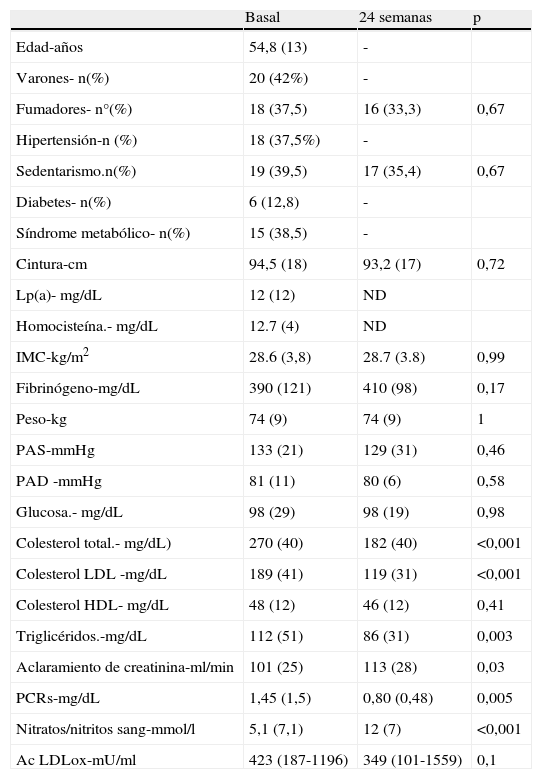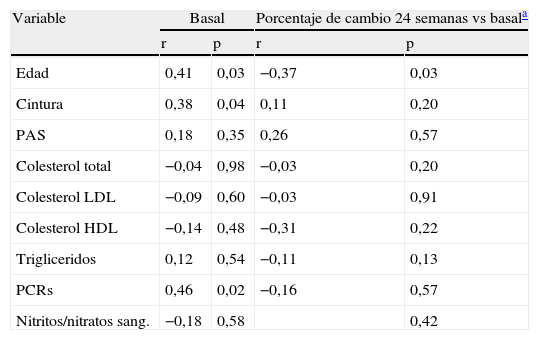En pacientes hipercolesterolémicos, estudiamos las relaciones de los valores plasmáticos de anticuerpos anti lipoproteínas de baja densidad (LDL) oxidadas con diferentes variables de interés cardiovascular y sus cambios tras el tratamiento con atorvastatina.
Pacientes y métodoEn 48 pacientes se determinaron los valores de anticuerpos anti-LDL oxidadas, biomarcadores lipídicos, de estrés oxidativo e inflamatorios, a la entrada del estudio y tras 24 semanas de tratamiento con 20mg de atorvastatina.
ResultadosLos valores basales de anticuerpos anti-LDL oxidadas se correlacionaron con la edad (r=0,41, p=0,03), cintura (r=0,38, p=0,04) y la proteína C reactiva ultrasensible (PCRs) (r=0,46, p=0,02), pero no con el resto de variables. El tratamiento con atorvastatina no disminuyó los valores de anticuerpos anti-LDL oxidadas (valor basal medio [intervalo de confianza del 95%] de 413 mUI/ml [187-1196] y a las 24 semanas de 349 mUI/ml [101-1559]). El porcentaje de cambio de anticuerpos anti-LDL oxidadas en la semana 24 se correlacionó negativamente con la edad (r=−0,37, p=0,03), pero no con cambios en el resto de las variables.
ConclusionesEn sujetos con hipercolesterolemia, los valores plasmáticos de anticuerpos anti-LDL oxidadas se relacionaron positivamente con la edad, cintura y PCRs. No se observaron cambios de los valores plasmáticos de anticuerpos anti-LDL oxidadas tras el tratamiento con atorvastatina, pero su variación se relacionó con la edad, lo que sugiere que las acciones inmunomoduladoras de las estatinas pueden depender de ésta.
In hypercholesterolemic patients, we studied the relationships of plasma levels of LDLoxab with cardiovascular variables and its changes after treatment with atorvastatin.
Patients and methodsWe studied, in 48 patients, the levels of LDLoxab, as well as lipid, oxidative stress and inflammatory biomarkers, at baseline and 24 weeks after treatment with 20mg of atorvastatin.
ResultsBaseline: a correlation was observed between LDLoxab and age (r= 0.41, P=.03), waist (r=0.38, P=.04) and C reactive protein (r= 0.46, P=.02), but not with other variables. Atorvastatin treatment did not decrease LDLoxab;(mU/mL, median [CI 95%]: baseline: 413 [187-1,196] and 24 weeks: 349 [101-1559]). The percentage change at week 24, was negatively correlated with age (r=−0.37, P=.03) but not with other variables.
ConclusionIn hypercholesterolemic subjects plasma LDLoxab levels were positively corelated with age, waist and C reactive protein. There were no changes in plasma levels of LDLoxab after treatment with atorvastatin, but the variation was associated with age, suggesting that the immunomodulatory actions may depend of this.
Artículo
Comprando el artículo el PDF del mismo podrá ser descargado
Precio 19,34 €
Comprar ahora








